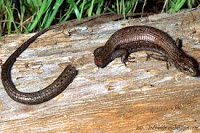One day, while Marlon was cleaning at his stockroom, a big gecko suddenly fell from the ceiling. To his surprise, he unintentionally hit it with a wood he was holding. The tail of the gecko was cut but was still moving even if it was already detached from its body.
You might be wondering what powers lizards or geckos have that they can still escape as fast as they could even after losing their tail or their limbs from a fight with another gecko or after you hit them. Also, after they’re no longer connected to its body, its tail is still able to flip, and jump.
Shedding appendages are a way of lizards to escape predators and threats. Researchers have known this ability as autonomy or self-amputation that is being exhibited by some animals, including lizards. This is common not only among lizards, but also to snakes, octopuses, spiders, and even a few mammals like Cuvier’s spiny rats.
Lizards can voluntarily shed parts of their bodies to avoid being eaten, but few studies have looked at the behavior of disposable body parts once they’ve fallen off. With the use of high-speed video and with electromyography, scientists found that severed gecko tails show complex behavior and react to environmental signals. (click here for more details)
For example, if a person loses a part of his body, usually that part immediately stops working once it was removed or cut off. For instance, the head chopped off, it would only retain consciousness for seconds at most. However, gecko or lizard tail can actively move for 30 minutes after its detachment from its body.
In 2009, Timothy Higham of the University of California, Riverside, and Anthony Russell of the University of Calgary in Alberta, Canada, showed that the geckos’ detached tails could pull off two different maneuvers. One is they rhythmically swing from side to side, and they also flip and jump up to 3 centimeters into the air for the first few minutes after amputation. (click here for more details)
According to scientists, figuring out what controls the jumping gecko tail may help in understanding why the paralyzed muscles of the spinal cord of injured patients sometimes exhibit spontaneous muscle contractions. They hope could this study with geckos can lead to treatments that could restore some control over such movements in humans.
In an experiment, the scientists attached electrodes to the tails of four adult leopard geckos, and then gently pinched the lizards to encourage them to shed their tails. As the gecko felt threatened, its tail began to twitch and eventually detached from the rest of its body in an amazing, but nearly bloodless, feat.
The severed tails were immediately stored in a recording arena. The gecko tails seemed to modulate their muscle movement to conserve energy and maximize their behavior’s unpredictability. The tails can independently sense and respond to their environment because they changed direction and speed depending on what they bumped into.
According to scientists, because of the central pattern generators or CPGs in the lizards, they can have rhythmic movements that are not controlled by the brain but by the network of neurons, however, how these neurons exactly functions is still a question to them. To be able to study CPGs, the scientists have to surgically damage the spinal cord of a particular animal in a procedure called spinal preparation. Still, geckos exhibit a unique ability to sever their spinal cord. (click here for more details)
Aside from the ability to sever its tail, lizards or geckos can grow them back in a process called regeneration. When a new lizard tail grows back, it looks different from its original tail. The new tail is often made out of cartilage, which can take out a little while to form.
The small green anole, which has a tail about four inches long, takes about two months to grow it back once it’s severed. Meanwhile, it might take more than a year for an iguana to grow back its long tail. Most lizards can regrow their tails many times except for crested gecko that once loses its tail, doesn’t grow it back. (click here for more details)
Regeneration of appendages is mostly exhibited by the amphibians, including the urodeles (salamanders and newts) and anurans (frogs and toads). This innate ability of animals is something that humans admire. But good thing humans don’t have this ability for if we do, criminals will have a quicker of running away from the police officers arresting by losing the handcuffed hands. (click here for more details)

